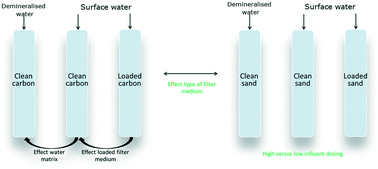Removal of nanoparticles (both inorganic nanoparticles and nanoplastics) in drinking water treatment – coagulation/flocculation/sedimentation, and sand/granular activated carbon filtration†
Abstract
Nanoparticles, such as metallic ones like Ag, Au and TiO2 as well as nanoplastics, are applied in or emitted by a wide variety of products or stem from degradation. Consequently, they end up in surface water, which is used as a source for drinking water production. This study investigated the removal of such nanoparticles by conventional water treatment processes Coagulation/flocculation/sedimentation (CFS), rapid sand filtration (RSF) and filtration over granular activated carbon (GAC) in different water matrices. In principle these processes appeared to remove the majority of nanoparticles. Lab-scale batch experiments confirmed that CSF may also be effective. In this study Au and Ag nanoparticles with a negative surface charge were used, as well as nanoplastics varying in size (50 and 200 nm) and surface charge (neutral and negative). It was found that the presence of negatively charged NOM has an adverse effect on inorganic nanoparticle removal, whereas the presence of cations like Ca2+ and Mg2+ is essential for good removal. In column experiments it was shown that the mechanism of nanoparticle removal by sand filtration differs from that by GAC filtration. A comparison of demineralized water and natural water showed that in sand filters the water matrix and the presence of biomass on the particles have a positive effect on the removal rate, whereas for GAC filters they have a distinct negative effect. Furthermore, larger nanoplastics (200 nm) were most efficiently removed by CFS, whereas smaller nanoplastics (50 nm) were removed better by GAC filtration. For smaller nanoparticles charge interactions play a more important role than for larger nanoparticles.



 Please wait while we load your content...
Please wait while we load your content...